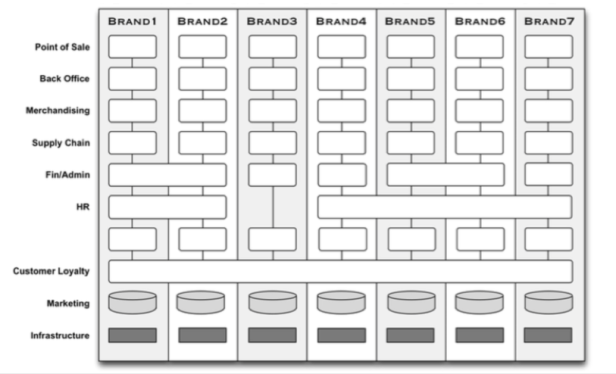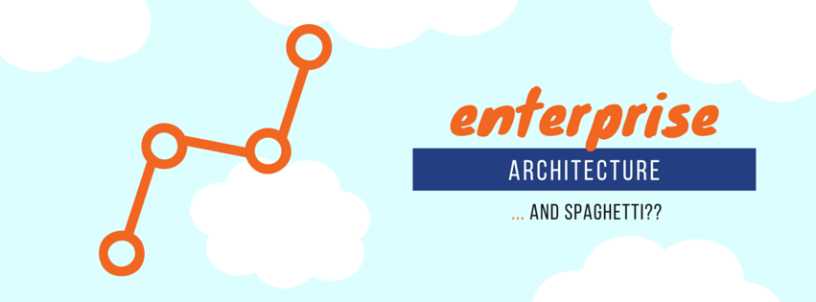Enterprise architecture has been accepted as an essential mechanism in companies to help with transparency, compliance, flexibility, and consistency. With the increasing use of social media in day-to-day life, there is a strong need to integrate social media analytics capability into current enterprise architecture to allow companies to manage and track important metrics.
What is Enterprise Architecture?
Enterprise architecture is a discipline for “leading enterprise responses to disruptive forces by identifying and analysing the execution of change toward desired business vision and outcomes”. Value is delivered through recommendations on policies and projects to help achieve target business outcomes.
 An example of a current state view – you can see that there are silos between departments. However even this example is quite organised compared to what can be found in organisations today.
An example of a current state view – you can see that there are silos between departments. However even this example is quite organised compared to what can be found in organisations today. This is just a popular example of how bad things can get – meet the spaghetti mess
This is just a popular example of how bad things can get – meet the spaghetti mess
 An example of a future state view – instead of systems being siloed between each department they are now connected and it is much more organised.
An example of a future state view – instead of systems being siloed between each department they are now connected and it is much more organised.
This video provides a quick overview of enterprise architecture in under four minutes, and it provides a very nice summary of what enterprise architecture is, how issues with “spaghetti mess” (or “hair ball architecture” as the video calls it) begin, as well as why you want to avoid it.
Gartner’s Pace-Layered Application Strategy
Gartner’s Pace-Layered Application Strategy is also insightful for some thinking into how and why a specific application is chosen for use by a business. Gartner defines the Pace-Layered Application Strategy as “a new methodology for categorising applications and developing a differentiated management and governance process” which reflects on how applications are used and any rates of change. Applications have been defined into three “layers” to help distinguish application types and aid in the development of more appropriate strategies.
- Systems of Innovation: These have a short life cycle of 0 to 12 months, and are applications built to support new, innovative business activities
- Systems of Differentiation: These have a medium life cycle of 1 to 3 years, and are applications that support processes unique to the organisation or industry
- Systems of Record: These are established applications making up an organisation’s systems of record and usually support
This method of layering is an interesting way of defining the different types of applications that a business may need over its lifetime.
In the next post we’ll be expanding this discussion on enterprise architecture and having a deeper look into the connections between enterprise architecture and social media networks.
What are your thoughts on enterprise architecture in businesses?
Sources
- Gartner, (2012). Gartner Says Adopting a Pace-Layered Application Strategy Can Accelerate Innovation. [online] Available at: http://www.gartner.com/newsroom/id/1923014 [Accessed 31 Mar. 2016].
- Gartner. (2012). Enterprise Architecture – EA – Gartner IT Glossary. [online] Available at: http://www.gartner.com/it-glossary/enterprise-architecture-ea/ [Accessed 1 Apr. 2016].
- Walker, M. (2009). Electronics Retailer – Application Diagram. [image] Available at: https://blogs.msdn.microsoft.com/mikewalker/2009/03/11/mapping-current-state-architectures-across-the-enterprise/ [Accessed 1 Apr. 2016].
- Wierda, G. (2013). Why Enterprise Architecture?. Available at: https://www.youtube.com/watch?v=qDI2oF1bASk [Accessed 1 Apr. 2016].
- Winter, R. & Sinz, E.J. 2007, “Enterprise Architecture”, Information Systems and eBusiness Management, vol. 5, no. 4, pp. 357-358.

This was an insightful article that provided a very clear summary of enterprise architecture and the “spaghetti mess” issue. I have never heard of Gartner’s Pace-Layered Application Strategy and it was interesting to learn how applications are divided into three layers to distinguish application types.
LikeLike
It was quite interesting for us when we first learnt about Gartner’s Pace-Layered Strategy too. I found it really helped when organising applications by type and understanding their purpose in the broader organisation.
LikeLike
Good post
LikeLike